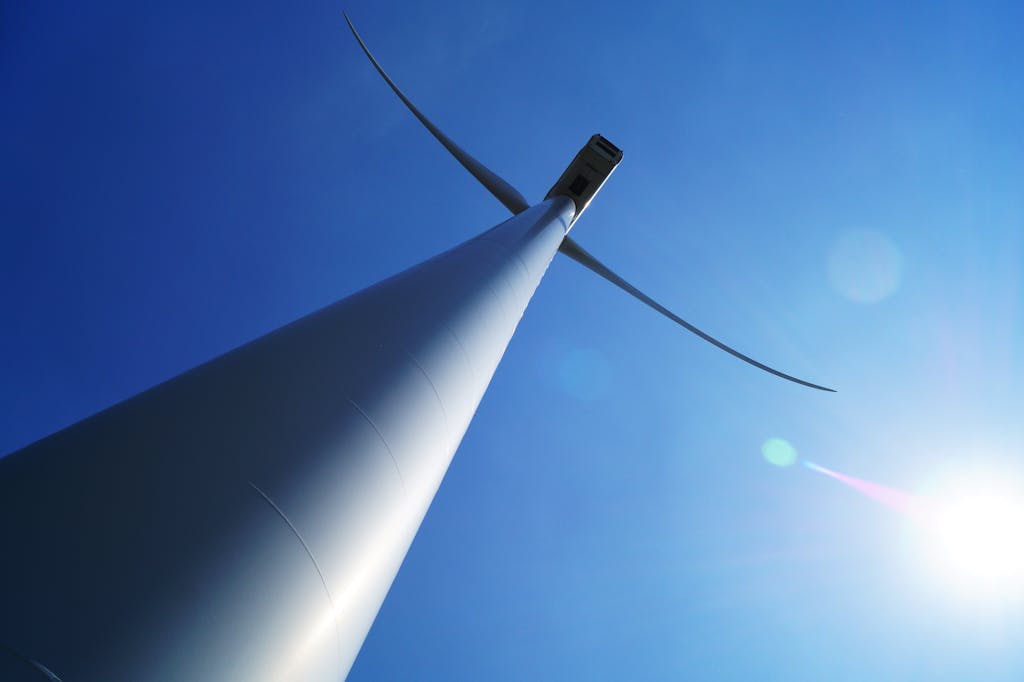The rise of renewable energy technology has changed how we generate power, but clean energy sources come with a challenge: they are intermittent by nature. The solution lies in balancing this inconsistent supply with the constant demand for electricity, ensuring reliability and efficiency.
Battery storage has emerged as a key innovation, capturing surplus energy during peak production and releasing it when needed. This technology makes renewable energy sources like solar and wind more practical and dependable.
What is renewable energy technology?
Renewable energy harnesses natural resources like solar power, wind, hydro and geothermal heat to generate clean electricity. These innovations aim to reduce reliance on fossil fuels while minimizing environmental impact. Systems such as solar panels, wind turbines and hydropower efficiently convert these resources into usable energy.
As new technology in renewable energy continues to evolve, advancements in solar, wind, hydro and geothermal technologies are critical for meeting affordable and clean energy sustainable development goals. These innovations not only increase efficiency but also make renewable energy more adaptable to various geographical and environmental conditions, driving the energy transition forward.
- Solar energy has seen remarkable progress through the development of photovoltaic cells. Modern solar panels are now more efficient at capturing sunlight, even in less-than-ideal conditions.
New designs, such as bifacial solar panels, can capture light from both sides, improving output. This renewable energy technology is vital for optimizing solar generation, making it a cornerstone of sustainable energy production. - Wind energy has also advanced considerably, with innovations in turbine technology allowing for more energy capture at lower wind speeds. This makes wind energy more reliable and accessible, especially in regions with less consistent wind patterns.
Modern turbines are designed to be more aerodynamic, which reduces drag and increases the rotation speed, generating more power with less input. These advances in renewable energy technology contribute to making wind a more dependable and scalable source of clean energy.

- Hydroelectric energy, traditionally reliant on large dams, is now shifting toward smaller, more sustainable installations that are also cost-effective.
- Geothermal energy is seeing innovations in drilling technology, allowing it to be harnessed in regions that were previously inaccessible. These advancements make geothermal power more adaptable to different environments.
What is IRESS?
IRESS, or Integrated Renewable Energy Storage Systems, is a cutting-edge energy solution that seamlessly merges renewable energy technologies with advanced energy storage methods. By integrating renewable energy sources such as solar and wind with battery storage systems, IRESS enables energy producers to maximize efficiency and minimize reliance on the grid.
With IRESS, excess power generated during peak renewable production can be stored using battery storage or other technologies, then dispatched when energy demand rises or generation drops. This not only stabilizes energy supply but also significantly enhances grid resilience and reliability.
As the energy sector accelerates toward decarbonization, IRESS stands out as a crucial innovation for optimizing clean energy assets. Whether through lithium-ion batteries or other storage systems, integrated renewable energy storage systems like IRESS are essential to achieving a more sustainable and efficient power ecosystem.
With continued innovation in renewable energy, storage solutions are becoming more efficient, allowing for greater energy retention and improving the overall reliability of renewable power.
How battery storage complements renewable energy
Battery storage systems, for instance, enhance the efficiency and reliability of renewable energy technology, making it crucial for ensuring a sustainable and stable energy future. Storage systems are also more space-efficient than adding more solar panels or wind turbines to generate more power.
- Solar energy: Energy produced during daylight hours can be stored and used at night, ensuring a continuous power supply.
- Wind energy: Surplus energy generated during strong winds can be stored and used when wind conditions are low.
- Hydroelectric energy: During times of high water flow, energy can be stored for later use during periods of reduced water availability.
- Geothermal energy: Excess heat generated from geothermal sources can be stored and used during peak demand, especially in regions with limited capacity for continuous extraction.

Emerging technologies in battery storage
As technology in renewable energy advances, efficient storage solutions become crucial for maximizing the potential of renewable sources.
Lithium-ion batteries
Lithium-ion batteries have become the preferred storage solution for many renewable energy systems, replacing traditional lead-acid batteries. They offer longer lifespans, higher energy, and power densities. These batteries are critical for managing the intermittency of solar and wind energy.
Over the past few years, the cost of lithium-ion batteries has significantly decreased, making them more accessible while increasing their capacity to store larger amounts of energy.
Solid-state batteries
Solid-state batteries represent the next phase of innovation in renewable energy storage. These differ from traditional lithium-ion batteries in that they use a solid separator instead of a liquid one, allowing ions to form a flat layer during charging. This design offers several advantages, including higher energy density—almost three times that of lithium-ion—providing almost three times the energy for the same weight.
These batteries are also potentially safer due to the lack of flammable liquids, offer faster charging times, and can be lighter, enhancing performance in devices and vehicles. These improvements make solid-state batteries a promising alternative for energy storage.
Flow batteries
Flow batteries differ from conventional batteries in that they store liquid electrolytes separately, which then flow into the central cell to enable the charging and discharging process. This design offers several advantages, including long energy storage durations, making them ideal for grid applications reliant on renewable energy.
These batteries are durable, with a service life of 20 years and minimal degradation. Flow batteries are also modular, compact and pose low fire risks, making them a promising innovation for large-scale renewable energy storage.
ACEN’s innovations in battery storage
ACEN is designing some of its large-scale renewable energy projects in the Philippines and Australia with battery storage in mind. Below are key projects showcasing ACEN’s commitment to advancing battery storage solutions across different regions.
Alaminos Energy Storage
ACEN’s Alaminos Energy Storage, together with the 120 MW Alaminos Solar, is the first hybrid solar and battery storage facility in the Philippines, featuring a 40 MWh capacity. It is designed to store excess energy from the adjacent 120 MW Alaminos Solar farm and release it when demand is high, helping to stabilize the grid.
This project includes 24 lithium-ion battery containers with 2.5 MVA battery capacity, powering around 3,290 homes and preventing approximately 9,580 metric tons of CO2 emissions annually.
ACEN Australia’s Battery Energy Storage System
ACEN Australia is developing a 200 MW/400 MWh (2-hour) Battery Energy Storage System (BESS) in New South Wales co-located with the 521 MW New England Solar farm. It is the first of two planned systems being built by leading international energy storage specialist Energy Vault and will be able to provide energy on demand to customers in both NSW and Queensland.
Once completed, it will be one of Australia’s largest co-located solar and battery energy storage facilities. The BESS will store and release energy during peak demand, playing a key role in supporting grid reliability as the country transitions to cleaner energy sources.
Vietnam’s first grid-connected storage system
Through its joint venture with AMI Renewables, ACEN is developing Vietnam’s first grid-connected BESS at the 50 MW Khanh Hoa Solar plant. The 7.5 MWh BESS, co-funded by U.S. Mission Vietnam, aims to demonstrate the commercial viability and efficiency of energy storage to support Vietnam’s renewable energy goals.
This pilot project, which plans to use a Honeywell energy storage system, will help stabilize the grid and contribute to the country’s target of achieving Net Zero emissions by 2050.
Powering a renewable energy future through innovation
Battery storage is essential for advancing renewable energy, ensuring a stable and reliable supply for solar, wind and other sources. By capturing and storing energy, these systems help manage fluctuations in natural energy production, making renewables more dependable.
Through innovation and strategic projects, ACEN is driving the energy transition forward for Asia Pacific.
References:
- Ahmed, U. (2023, September 1). Recent developments in geothermal energy. AZoCleantech.com. https://www.azocleantech.com/article.aspx?ArticleID=1717
- Flow Batteries Europe. (2022, June 16). Sustainability and safety of flow batteries – Flow Batteries Europe. Flow Batteries Europe. https://flowbatterieseurope.eu/flow-batteries/safety-of-flow-batteries/
- Gorman, S. (2023, August 24). 6 Ways Solid-state Batteries Are Better than Lithium-ion Ones… | CPI. Www.uk-Cpi.com. https://www.uk-cpi.com/blog/6-ways-solid-state-batteries-are-better-than-lithium-ion-alternatives-in-electric-vehicles
- ISO. (2019). Energy storage: Powering the future of renewable energy. ISO. https://www.iso.org/renewable-energy/storage
- Laurie, C. (2023, September 22). Technology Advancements Could Unlock 80% More Wind Energy Potential During This Decade. NREL. https://www.nrel.gov/news/program/2023/technology-advancements-could-unlock-80-more-wind-energy-potential-during-this-decade.html
- MarineBio. (n.d.). Hydropower ~ MarineBio Conservation Society. MarineBio. https://www.marinebio.org/conservation/hydropower/
- Omar H, A.-Z., Rebhi A, D., A H, A.-Z., Hamza , A.-T., A Odat, A.-S., & Bashar, S. (2024). Evaluating the real-world performance of vertically installed bifacial photovoltaic panels in residential settings: empirical findings and implications. International Journal of Low-Carbon Technologies, 19, 386–442. https://doi.org/10.1093/ijlct/ctad138
- Pastorelli, A. (2022, March 9). Solid-state batteries: how they work. Flash Battery. https://www.flashbattery.tech/en/how-solid-state-batteries-work/
- Ritchie, H. (2021, June 4). The price of batteries has declined by 97% in the last three decades. Our World in Data. https://ourworldindata.org/battery-price-decline
- Scott, A. (2023, July 30). Flow batteries, the forgotten energy storage device. Chemical & Engineering News. https://cen.acs.org/materials/energy-storage/Flow-batteries-forgotten-energy-storage/101/i25
- Stauffer, N. (2023, April 7). Flow batteries for grid-scale energy storage. MIT News | Massachusetts Institute of Technology. https://news.mit.edu/2023/flow-batteries-grid-scale-energy-storage-0407
- United Nations. (n.d.). What Is Renewable Energy? United Nations. https://www.un.org/en/climatechange/what-is-renewable-energy
- University of Washington. (2020). Lithium-Ion Battery. Clean Energy Institute; University of Washington. https://www.cei.washington.edu/research/energy-storage/lithium-ion-battery/

